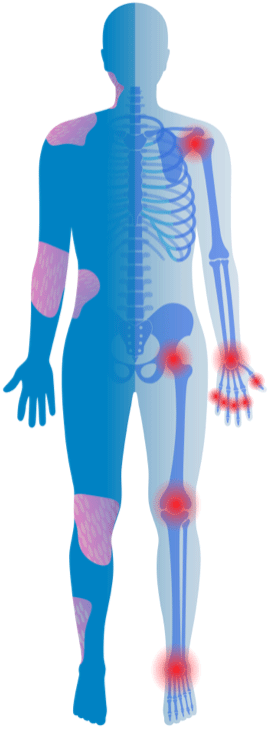On January 21, 2022, the SKYRIZI (risankizumab-rzaa) Prescribing Information and Medication Guide were updated to include new information about serious allergic reactions.
The following describes the recent changes to the SKYRIZI Medication Guide. Please refer to the full Prescribing Information and Medication Guide for additional safety information.
The following serious side effects were added to the section “What is the most important information I should know about SKYRIZI?”
SKYRIZI may cause serious side effects, including:
Serious allergic reactions. Stop using SKYRIZI and get emergency medical help right away if you get any of the following symptoms of a serious allergic reaction:
- fainting, dizziness, feeling lightheaded (low blood pressure)
- swelling of your face, eyelids, lips, mouth, tongue, or throat
- trouble breathing or throat tightness
- chest tightness
- skin rash, hives
- itching
Who should not use SKYRIZI?
Do not use SKYRIZI if you are allergic to risankizumab-rzaa or any of the ingredients in SKYRIZI. See the end of the Medication Guide for a complete list of ingredients in SKYRIZI here.
This is not a complete list of all the changes made to the Prescribing Information and Medication Guide for SKYRIZI. Please refer to the full Prescribing Information and Medication Guide for additional safety information.
INDICATIONS1
SKYRIZI is a prescription medicine used to treat adults:
• with moderate to severe plaque psoriasis who may benefit from taking injections or pills (systemic therapy) or treatment using ultraviolet or UV light (phototherapy).
• with active psoriatic arthritis (PsA).
Important Safety Information1
What is the most important information I should know about SKYRIZI® (risankizumab-rzaa)?
SKYRIZI is a prescription medicine that may cause serious side effects, including:
Serious allergic reactions:
• Stop using SKYRIZI and get emergency medical help right away if you get any of the following symptoms of a serious allergic reaction:
− fainting, dizziness, feeling lightheaded (low blood pressure)
− swelling of your face, eyelids, lips, mouth, tongue, or throat
− trouble breathing or throat tightness
− chest tightness
− skin rash, hives
− itching
Infections:
SKYRIZI may lower the ability of your immune system to fight infections and may increase your risk of infections. Your healthcare provider should check you for infections and tuberculosis (TB) before starting treatment with SKYRIZI and may treat you for TB before you begin treatment with SKYRIZI if you have a history of TB or have active TB. Your healthcare provider should watch you closely for signs and symptoms of TB during and after treatment with SKYRIZI.
• Tell your healthcare provider right away if you have an infection or have symptoms of an infection, including:
− fever, sweats, or chills
− cough
− shortness of breath
− blood in your mucus (phlegm)
− muscle aches
− warm, red, or painful skin or sores on your body different from your psoriasis
− weight loss
− diarrhea or stomach pain
− burning when you urinate or urinating more often than normal
Do not use SKYRIZI if you are allergic to risankizumab-rzaa or any of the ingredients in SKYRIZI.
Before using SKYRIZI, tell your healthcare provider about all of your medical conditions, including if you:
• have any of the conditions or symptoms listed in the section “What is the most important information I should know about SKYRIZI?”
• have an infection that does not go away or that keeps coming back.
• have TB or have been in close contact with someone with TB.
• have recently received or are scheduled to receive an immunization (vaccine). Medications that interact with the immune system may increase your risk of getting an infection after receiving live vaccines. You should avoid receiving live vaccines right before, during, or right after treatment with SKYRIZI. Tell your healthcare provider that you are taking SKYRIZI before receiving a vaccine.
• are pregnant or plan to become pregnant. It is not known if SKYRIZI can harm your unborn baby.
• are breastfeeding or plan to breastfeed. It is not known if SKYRIZI passes into your breast milk.
Tell your healthcare provider about all the medicines you take, including prescription and over-the-counter medicines, vitamins, and herbal supplements.
What are the possible side effects of SKYRIZI?
SKYRIZI may cause serious side effects. See “What is the most important information I should know about SKYRIZI?”
The most common side effects of SKYRIZI include upper respiratory infections, feeling tired, fungal skin infections, headache, and injection site reactions.
These are not all the possible side effects of SKYRIZI. Call your doctor for medical advice about side effects.
Use SKYRIZI exactly as your healthcare provider tells you to use it.
SKYRIZI is available in a 150 mg/mL prefilled syringe and pen.
You are encouraged to report negative side effects of prescription drugs to the FDA. Visit www.fda.gov/medwatch or call 1-800-FDA-1088.
If you are having difficulty paying for your medicine, AbbVie may be able to help. Visit AbbVie.com/myAbbVieAssist to learn more.
Please see accompanying full Prescribing Information or visit www.rxabbvie.com/pdf/skyrizi_pi.pdf.
Reference: 1. SKYRIZI [package insert]. North Chicago, IL: AbbVie Inc.
©2022 AbbVie. All rights reserved. US-SKZD-220015 January 2022





